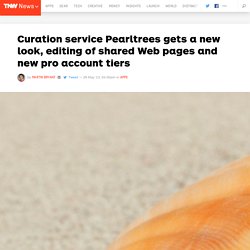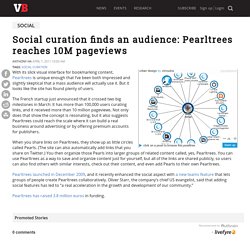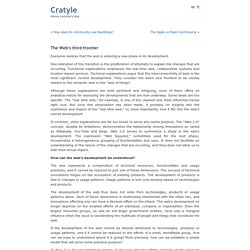

Interview de Patrice Lamothe – Pearltrees. Pearltrees Gets a New Look, New Features and New Premium Tiers. Pearltrees, the social curation service that helps you organise Web content, photos and notes (‘pearls’) into mindmap-style ‘trees’, is today unveiling a new look, new features for paying users and revised pro account tiers.

Pearltrees was launched in December 2010 and now boasts two million monthly active users, collecting over 50,000 links every day. The new UI, codenamed ‘Asimov’ by the French startup, is designed to provide a coherent, simpler experience across the Web, iOS and a forthcoming Android version. There’s nothing enormously different about it, although there’s now an Apple-style ‘dock’ at the bottom of the page for universal options and a subtly more friendly look that uses responsive design to optimize the layout for different screen sizes. The updated iOS version, which will be available as soon as it’s approved by Apple, promises to get rid of one my biggest bugbears when it comes to curation apps – the Safari bookmarklet. Now, there are three paid tiers: (1) Robert Scoble - Google+ - First look at Pearltrees' new iPhone app +Pearltrees is… Rejoindre Google+ Partagez ce que vous voulez avec qui vous voulez Envoyer des commentaires Aide · Définir la région Pour les lecteurs d'écran : cliquez ici pour activer le mode d'accessibilité.
Pearltrees Gives Itself A Visual Refresh With New Customization Options, Major Redesign Coming Soon. Pearltrees, the Paris-based curation and discovery service, just launched a new version of its web and mobile apps.

The update introduces a visual refresh with full-screen images that now automatically appear as backgrounds for all of your pearltrees – the mind map-like tree structures that you use for organizing your collections on the site. While the service previously featured a very abstract representation of the bookmarks, images, texts and other items you save on the site, the new version now shows you more realistic ‘pearls.” A pearl, the company says, now “presents a view of what it contains, making what’s inside immediately recognizable.” Social curation finds an audience: Pearltrees reaches 10M pageviews. With its slick visual interface for bookmarking content, Pearltrees is unique enough that I’ve been both impressed and slightly skeptical that a mass audience will actually use it.

But it looks like the site has found plenty of users. The French startup just announced that it crossed two big milestones in March: It has more than 100,000 users curating links, and it received more than 10 million pageviews. Five types of content curation tools for journalists. The opening panel session in our upcoming news:rewired digital journalism conference on 19 April will cover the growing role of journalists in curating content from social media and the wider web.

With two weeks to go today (tickets still available here) we decided to highlight some useful tools for differing sectors of content curation. This is by no means an exhaustive or definitive list so feel free to recommend any further tools or platforms in the comments section below. General By cogdogblog by Flickr. Some rights reserved. Storify Storify originally only allowed users to gather material from social media sites such as Twitter, Facebook, Flickr and YouTube but this has grown to now include a wide range of content sources including Tumblr posts, Instagram photos, google searches and embedded URLs.
Many news organisations use the platform to curate stories.
Beta Launch. Serie B founding round. The iPad app. Pearltrees makes Web curation a joy with its ‘magical’ new iPad app. Not many tech CEOs would have the guts to describe their products as “magical” and as delivering “pure happiness”, but that’s exactly how Pearltrees‘ Patrice Lamothe describes the startup’s iPad app released today.

You know what? He may just be right. Pearltrees is a service that takes a visual approach to Web curation. Launched late last year with its browser-based version, it allows you to create networks of ‘pearls’ on screen. Each pearl is a link to a piece of content and you can connect them together in whatever way you choose into a ‘pearltree’. Everything’s public on Pearltrees, so searching for ‘iPhone’, for example, will bring up all the iPhone-relates pearltrees created by 200,000 users the service has amassed so far. Now the iPad app brings a whole new dimension to both curation and content discovery. That’s where the discovery element of the app comes in. Scroll your finger slowly to uncover closely related pearls, or scroll quickly to see a wider variety of related content. Scobleizer: It's not often anymore that...
"Pearltrees introduces cool new UI to web. Blog Archive » The Web’s third frontier. Everyone realizes that the web is entering a new phase in its development.

One indication of this transition is the proliferation of attempts to explain the changes that are occurring. Functional explanations emphasize the real time web, collaborative systems and location-based services. Technical explanations argue that the interconnectivity of data is the most significant current development. They consider the web’s new frontiers to be closely related to the semantic web or the “web of things”. Although these explanations are both pertinent and intriguing, none of them offers an analytical matrix for assessing the developments that are now underway. In contrast, other explanations are far too broad to serve any useful purpose. How can the web’s development be understood? The web represents a compendium of technical resources, functionalities and usage practices, and it cannot be reduced to just one of these dimensions.
The founding principles The two initial phases of growth.